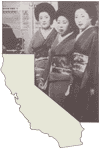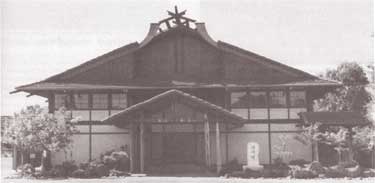![]()

Five Views: An Ethnic Historic Site Survey for California
MENU
Introduction
Immigration
Settlement
Organizations/Religion
Discrimination
World War II Incarceration
Historic Sites
Selected References

A History of Japanese Americans in California:
HISTORIC SITES
Concord Nippongo Gakko
(Concord Japanese Language Institute)
Concord, Contra Costa County
The Concord Nippongo Gakko (Concord Japanese Language Institute), now known as the Diablo Japanese American Religious and Cultural Center, is a combination gymnasium and meeting hall, with additional rooms for classrooms. Immediately in front of the structure is a large parking area and a monument erected in 1980, dedicated to Japanese pioneers in the Diablo area. The building incorporates Japanese architectural styling, characterized by a tiled roof topped by wooden beams. Shoji screens have been installed in each window. The center is an imposing stucco and wood building with a simple rock garden, amid the surrounding developments of townhouses and condominiums.
The Concord Japanese Language Institute served as the community center for social and cultural activities of Japanese living in the Diablo-San Ramon Valley of Contra Costa County. The papers of incorporation for the institute were signed October 22, 1926. As "aliens ineligible to citizenship," the issei were excluded from land ownership. Therefore, three nisei children, Tsutomu Iseri, Hideo Hoshi, and Yoshikazu Kurotori, were selected to serve as directors of the institute.
The institute offered instruction in Japanese and English, and provided kindergartens and playgrounds for the youngsters.
A Japanese-language school had originally been established at the "Adobe House" in Concord. The issei realized the need for a permanent structure to house the language school. Although several sites were considered for the school, it was decided that the Concord Institute would be built on two acres of land donated by Kumetaro Tamori and Honkichi Tamori. From about 1927 to 1930, contributions were collected from the Japanese community. The Concord Institute was built by two issei carpenters, Izumi and Tamaki, from San Jose, with the help of the issei on weekends.
In the 1930s, the building became a center for issei social activities. There was an issei baseball team around 1920-21. These was also a nisei baseball team, known as the Concord O'Doul Baseball Team, which competed in the Nisei Baseball League. The league included teams from Vacaville, Isleton, Walnut Grove, Mt. Eden, Oakland, Sebastopol, and other areas. The nisei team at the Concord Institute existed from approximately 1929 to 1940. The Contra Costa JACL also used the building from 1937 to 1942.
One of the first instructors of the Concord Institute was Saburo Sasaki. On March 9, 1940, the deed to the land for the institute was transferred by Kumeo and Shoji Tamori. From oral histories, it is known that the organizing officers of the institute were Kumetaro Tamori, President; Nentaro Ide and Seijiro Hara, Vice Presidents; Yasuhei Sakamoto, Treasurer; Sakae Morodomi, Manager; and Genkichi Mukuno, co-manager. Those participating in the initial organizing meetings were Kumetaro Tamori, Nentaro Ide, Seijiro Hara, Yasuhei Sakamoto, Sakae Morodomi, Genkichi Mukuno, Sakichi Shibata, Matsutaro Harano, Daijiro Noma, Yoshikazu Sano, Yonesaku Horiuchi, Yonesaku Kanagaki, Minesuke Nitasaka, Shigesaburo Moshi, Buntaro Hara, Goroichi Hirose, Sagao Kido, Kumezo Obata, and Yuzo Yamamoto.
During World War II, the building was leased to a Caucasian, with the understanding that the rent was to pay taxes on the property. A local lawyer was given power of attorney over the property when Japanese were moved to concentration camps. When Japanese returned after the war, they discovered that the property taxes were delinquent, and the attorney would not release the property to them. The returning Japanese regained the power of attorney. The cost of back taxes and attorney's fees to regain the property was paid by community donations.
During the reconstruction period after the war, returning Japanese, along with other Japanese who came to live in the Diablo area, established the Diablo Japanese American Club in 1952. Thus, activities of the institute expanded to include families other than those with children. In 1953, the building was remodeled, and in 1954, the school was opened after being closed since 1942. Activities of the club included ikebana, shigin, judo, bonsai, a gardeners' association, Higashi Honganji, and Nishi Honganji meetings. In 1957, the fund-raising summer festival was started, and continues to this day.
In 1971, the Concord Buddhist Sunday School became the holder of the deed. The original building was moved in 1971 to make way for construction of a new building. The original building, donated to the We Care Center, a private nonprofit school for disabled children, was relocated across from the Concord Pavilion. The new building is now known as the Concord Japanese American Religious and Cultural Center.
The 50th anniversary was observed May 20, 1979, and a stone monument was erected the following year commemorating the event. The Concord Institute still conducts Japanese-language classes on weekends at the center.

Concord Nippongo Gakko, Concord, Contra Costa County
NEXT> Harada House
Last Modified: Wed, Nov 17 2004 10:00:00 pm PDT
http://www.cr.nps.gov/history/online_books/5views/5views4h15.htm
![]()
 Top
Top